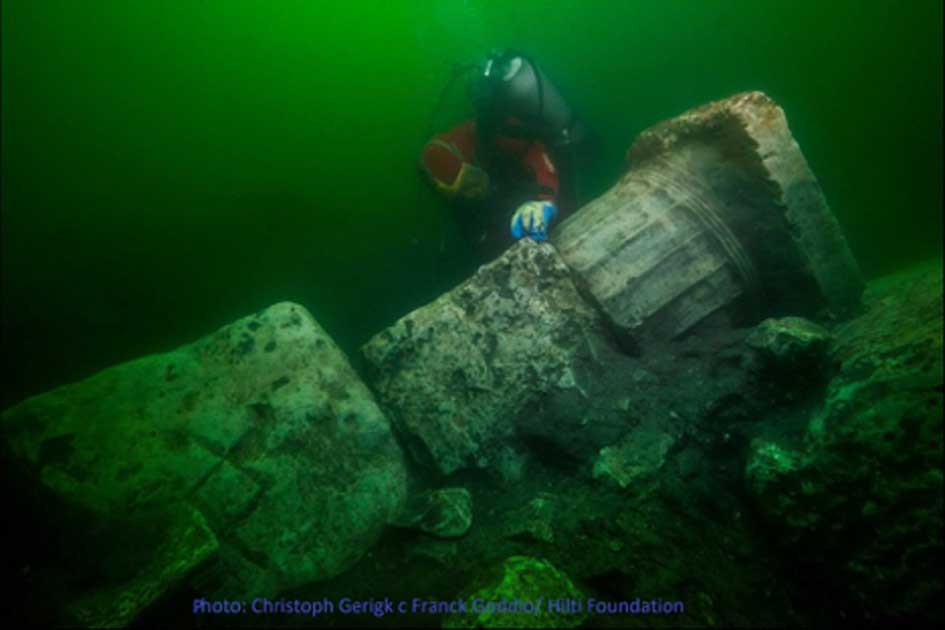Subaquatic Temple and Countless Treasures Discovered in Egypt's Sunken City of Heracleion
Egypt's Ministry of Antiquities has announced that marine archaeologists diving at the ancient submerged city of Heracleion (named after Hercules who legend claimed had been there) off the coast of the Nile Delta have discovered the remains of a temple, docks and boats containing ancient treasures.
Waterlogged City of Heracleion
No doubt we’ve all heard of the legend of Atlantis, the great ancient city engulfed by the ocean in pre-history that’s yet to be found, or proven to have ever existed; yet over the last 20 years another underwater city has been found and it’s treasures are as haunting as they are mind blowing. Like Atlantis, for centuries it was thought to be no more than a legend, famed to have been visited by Helen of Troy and Paris, her lover, before being tragically submerged in a catastrophic event.
In fact, Heracleion was real, and was home of the temple where Cleopatra was inaugurated, before being consumed by the Mediterranean Sea nearly 1,200 years ago. Known as Thonis in Egypt, submerged under 150 feet of water, the city sits in what is today the Bay of Aboukir, but in the 8th century BC when the city is thought to have been built, it would have been situated at the mouth of the River Nile delta where it opened into the Mediterranean Sea.

Gold jewelry found on the seabed site. (Christoph Gerigk - Frank Goddio/ Hilti Foundation/ Egyptian Antiquities Authority)
The circumstances surrounding the discovery of this important ancient trade center were discussed in this 2013 Ancient Origins article when in the year 2000 an underwater archaeologist ‘searching for French warships’ stumbled across the sunken city and its many lost treasures. Researcher Franck Goddio who led the new team of divers said on his blog that the “latest archaeological dive revealed the city's main temple and the remains of a smaller Greek temple” as well as “ancient columns and bronze coins from the reign of King Ptolemy II” which date to between 283 and 246 BC, and older pottery from the third and fourth centuries BC.

Coin recovered from the site. (Christoph Gerigk - Frank Goddio/ Hilti Foundation/ Egyptian Antiquities Authority)
The Problem with Liquefaction
Over the years the main sunken temple of Amun-Gerb has been found to contain hoards of treasures, for example, according this recent article in News Night; “dozens of sarcophagi, giant statues of pharaohs, a sphinx and hundreds of god and goddess statues, 64 ancient ships, 700 anchors and gold coins and weights made from bronze and stone.”
The new dive team found a “clutch of new ports” which effectively extends their map of the ancient sunken city “by about two-thirds of a mile” and they have also added to their mapping of Canopus, a second submerged city close to Heracleion. What’s more, one of the scores of ancient ships at the site from the fourth century BC was found to contain “crockery, coins and jewelry in one now fully-excavated vessel.”
- The Quest for the Mythical Submerged Temples of Mahabalipuram
- The Crowns of the Pharaohs
- 10 Sensational Sunken Kingdoms: Atlantis’ Companions Beneath the Waves
Scientists are still challenged trying to answer what caused the city to slide into the sea nearly 1,000 years after its construction, but it’s generally agreed that gradual sea level rise and a sudden collapse of the cities unstable sediment caused the whole area to sink by around 12 feet (3.65 meters). A 2013 article in The Guardian explains that after a severe flood, the central island, which was already sagging under the weight of the main temple buildings, finally succumbed to “liquefaction”. Basically, the clay soil turned to liquid in a few moments and the whole city crashed into the sea and over time its memory faded and the only record of its existence remained in a few ancient texts.

Coin recovered from the site. (Christoph Gerigk - Frank Goddio/ Hilti Foundation/ Egyptian Antiquities Authority)
Playing Chess with Mother Nature
In reading about ancient ecological catastrophes like the tale of Thonis-Heracleion, maybe the hardest part to rationalize with is how a center of advanced shipping and trading technologies driven by human ingenuity could one afternoon just slide into the sea and be forgotten. And while the tons of inanimate artifacts and treasures recovered from the sunken city spellbind and intrigue us, each one holds memories of a long-forgotten urban lifestyle and a starkly dark reminder of just how fragile many of our own contemporary cities are.
A 2015 article in The Guardian titled ‘ What is the world's most vulnerable city?’ says Thonis-Heracleion’s closest modern cousin is Venice owing to its being situated on a lagoon with a network of waterways - and it is sinking. Egypt’s Mediterranean coastline is gravely threatened with rising sea levels and even the most optimistic global temperature increase projections displace millions in the region from their homes within the next four decades.
Thonis-Heracleion’s millennium long legacy rests on the seabed and serves as subaquatic window to our urban past and a reminder of how we play chess with nature, and her pieces; ‘climate and weather’ always checkmate our kings, whenever she pleases.
Top image: Temple remains have been found at Heracleion Source: (Christoph Gerigk - Frank Goddio/ Hilti Foundation/ Egyptian Antiquities Authority)
By Ashley Cowie

















